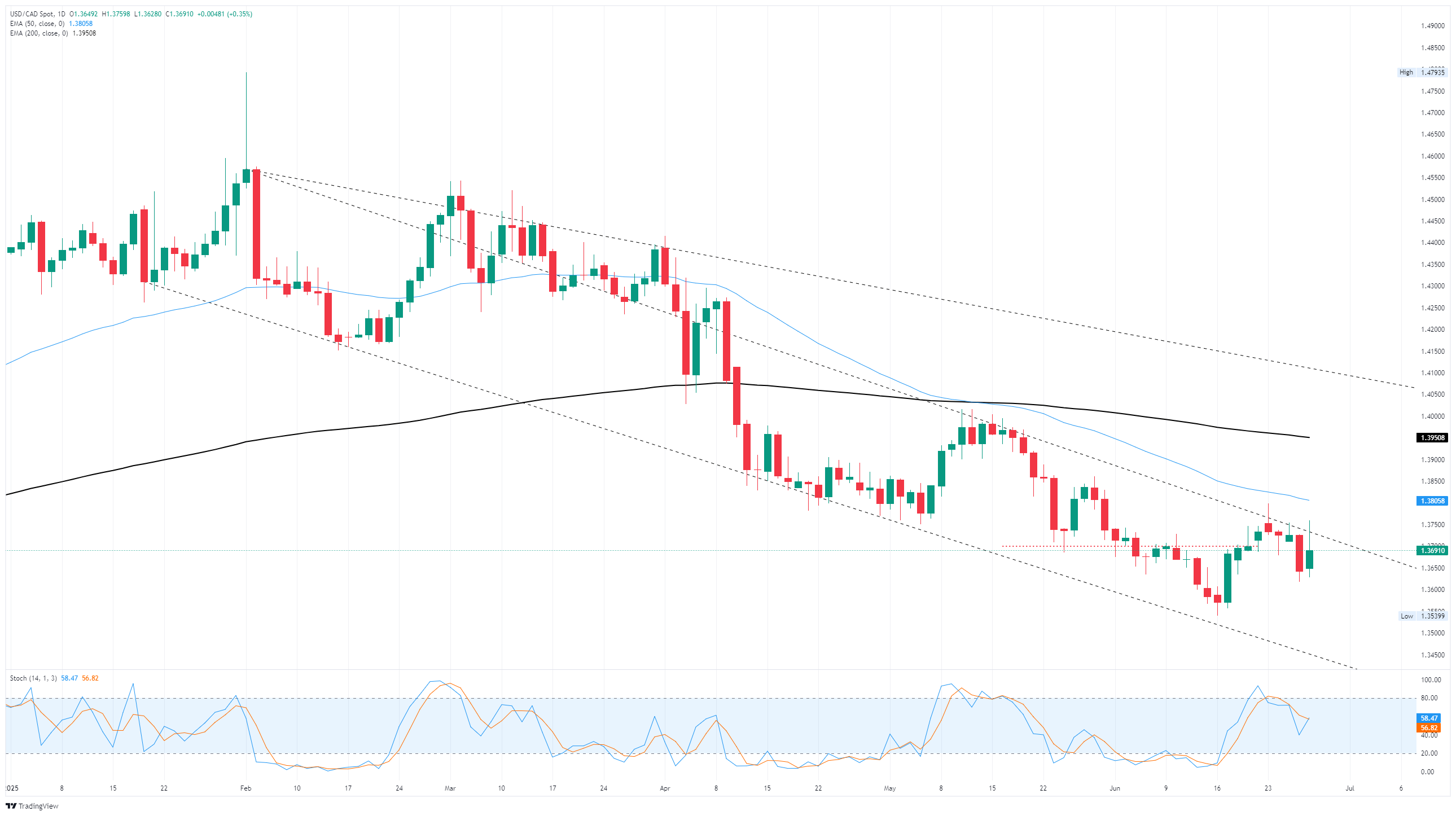Canadian Dollar snaps lower after Trump pulls the plug on trade talks with Canada
- The Canadian Dollar sharply pared back near-term gains on Friday.
- US President Donald Trump has announced that his team is ending all trade talks with Canada.
- Canadian GDP growth contracted in April, adding further downside pressure to Loonie flows.
The Canadian Dollar (CAD) backslid on Friday, falling back on a combination of weakening Canadian Gross Domestic Product (GDP) growth metrics and fresh trade tensions with US President Donald Trump. The Trump team appears to be pulling up stakes and abandoning the trade negotiation table entirely, with Donald Trump announcing that he was taking his ball and going home in a social media post Friday afternoon.
Canadian GDP growth contracted in April, knocking Loonie sentiment slightly lower. Between easing inflation data and declining growth prospects, investor bets of a fresh batch of rate cuts from the Bank of Canada (BoC) are on the rise.
Daily digest market movers: Canadian Dollar slumps amid slowing growth, fresh tariff threats from Trump
- The Canadian Dollar pared back near-term gains, falling against the Greenback and bolstering the USD/CAD pair into the 1.3750 level on Friday.
- Canadian GDP contracted by 0.1% in May. The growth print carries little weight independently, but it does add a little bit more confidence to traders betting on a return to rate cuts from the BoC.
- US President Donald Trump proclaimed via social media post on Friday that he would be pulling the US out of trade talks with Canada entirely.
- Donald Trump misattributed dairy tariff levels that are already covered under his own bespoke USMCA trade deal that he negotiated during his first term, and stated that he would be announcing more tariffs on Canada in the next seven days.
- President Trump appears to be frustrated that Canada is going ahead with closing a predatory taxation loophole that allows US tech companies to sell their products in Canadian markets tax-free. The new fee coming into effect on cross-border tech services has been years in the making, but the Trump administration has waited until the eleventh hour to pull up all stakes.
Canadian Dollar price forecast
A fresh bullish pivot in the USD/CAD pair, bolstered by a fresh bout of Loonie weakness, has pushed the Loonie-Dollar pairing back into a descending trendline drawn from multi-decade highs posted in January. Overall trend momentum is still tilted in favor of the Canadian Dollar as the US Dollar buckles under the weight of global selling pressure, but near-term shocks to CAD stability could see USD/CAD knock back into the high side and challenge the 200-day Exponential Moving Average (EMA) near 1.3950.
USD/CAD daily chart

Canadian Dollar FAQs
The key factors driving the Canadian Dollar (CAD) are the level of interest rates set by the Bank of Canada (BoC), the price of Oil, Canada’s largest export, the health of its economy, inflation and the Trade Balance, which is the difference between the value of Canada’s exports versus its imports. Other factors include market sentiment – whether investors are taking on more risky assets (risk-on) or seeking safe-havens (risk-off) – with risk-on being CAD-positive. As its largest trading partner, the health of the US economy is also a key factor influencing the Canadian Dollar.
The Bank of Canada (BoC) has a significant influence on the Canadian Dollar by setting the level of interest rates that banks can lend to one another. This influences the level of interest rates for everyone. The main goal of the BoC is to maintain inflation at 1-3% by adjusting interest rates up or down. Relatively higher interest rates tend to be positive for the CAD. The Bank of Canada can also use quantitative easing and tightening to influence credit conditions, with the former CAD-negative and the latter CAD-positive.
The price of Oil is a key factor impacting the value of the Canadian Dollar. Petroleum is Canada’s biggest export, so Oil price tends to have an immediate impact on the CAD value. Generally, if Oil price rises CAD also goes up, as aggregate demand for the currency increases. The opposite is the case if the price of Oil falls. Higher Oil prices also tend to result in a greater likelihood of a positive Trade Balance, which is also supportive of the CAD.
While inflation had always traditionally been thought of as a negative factor for a currency since it lowers the value of money, the opposite has actually been the case in modern times with the relaxation of cross-border capital controls. Higher inflation tends to lead central banks to put up interest rates which attracts more capital inflows from global investors seeking a lucrative place to keep their money. This increases demand for the local currency, which in Canada’s case is the Canadian Dollar.
Macroeconomic data releases gauge the health of the economy and can have an impact on the Canadian Dollar. Indicators such as GDP, Manufacturing and Services PMIs, employment, and consumer sentiment surveys can all influence the direction of the CAD. A strong economy is good for the Canadian Dollar. Not only does it attract more foreign investment but it may encourage the Bank of Canada to put up interest rates, leading to a stronger currency. If economic data is weak, however, the CAD is likely to fall.

